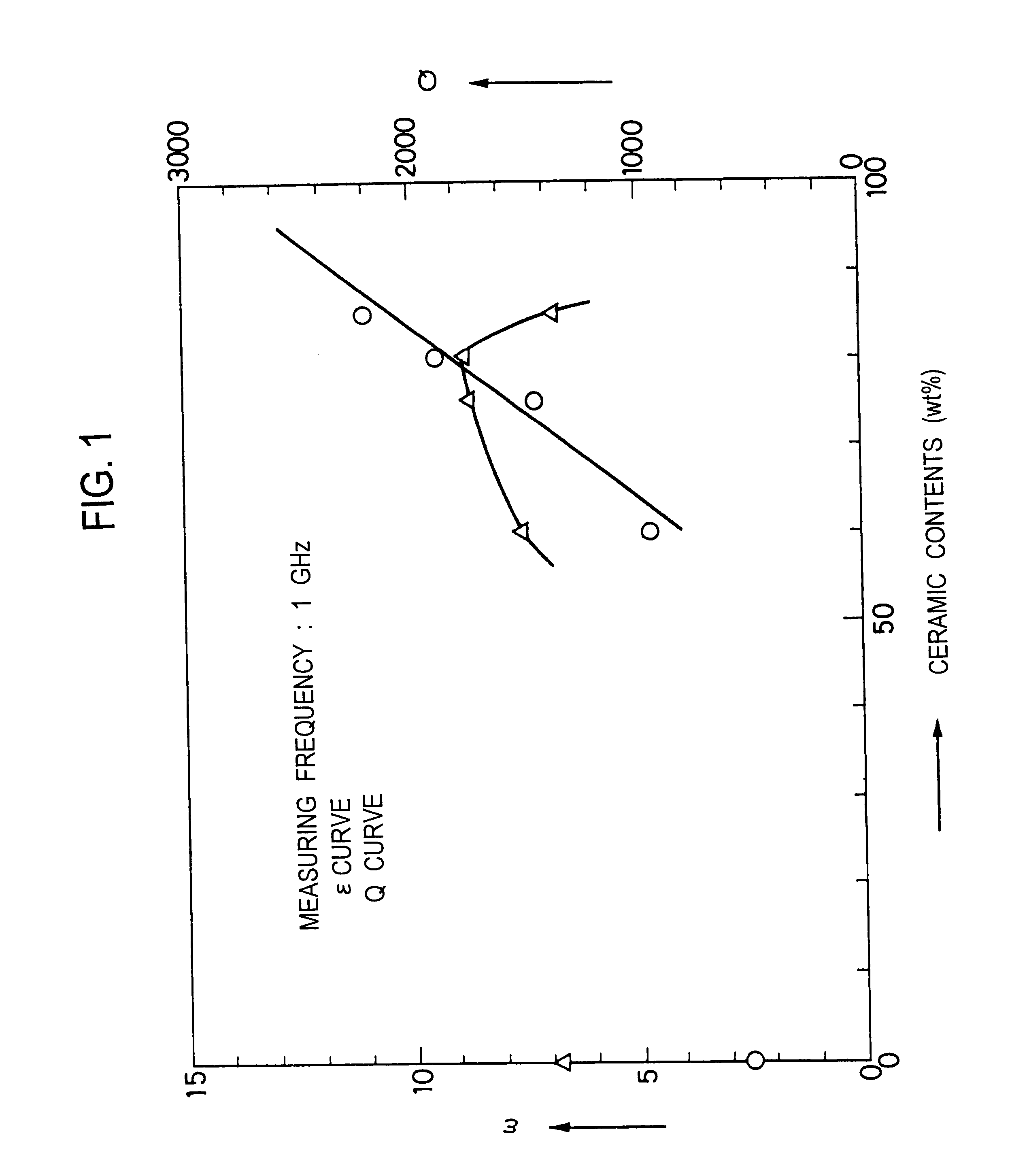Composite dielectric material composition, and film, substrate, electronic part and molded article produced therefrom
a technology of dielectric material and composition, which is applied in the direction of high frequency circuit adaptation, other chemical processes, plastic/resin/waxes insulators, etc., can solve the problems of low heat resistance, dielectric loss of device circuits, and energy loss of transmission processes
- Summary
- Abstract
- Description
- Claims
- Application Information
AI Technical Summary
Benefits of technology
Problems solved by technology
Method used
Image
Examples
synthesis example 1
In a stainless autoclave of 5 liters in volume, 2.5 grams of a suspending agent or polyvinyl alcohol were dissolved in 2,500 grams of pure water. Seven hundred (700) grams of an olefinic polymer or polypropylene (made by Nippon Polyolefin Co., Ltd. and available under the trade name of J Alloy 150G) were placed in the solution for stirring and dispersion. Apart from this, 1.5 grams of a radical polymerization initiator or benzoyl peroxide and 9 grams of a radical-polymerizable organic peroxide or t-butylperoxymethacryloyloxyethyl carbonate were dissolved in 300 grams of an aromatic monomer or styrene to prepare another solution. This solution was charged in the autoclave for stirring with the first-mentioned solution. Then, the autoclave was brought up to a temperature of 60 to 65.degree. C. for a two-hour stirring, thereby impregnating the polypropylene with the vinyl monomer containing the radical polymerization initiator and radical-polymerizable organic peroxide. Then, the autoc...
synthesis example 2
In a stainless autoclave of 5 liters in volume, 2.5 grams of a suspending agent or polyvinyl alcohol were dissolved in 2,500 grams of pure water. Seven hundred (700) grams of an olefinic polymer or polypropylene (made by Nippon Polyolefin Co., Ltd. and available under the trade name of J Alloy 150G) were placed in the solution for stirring and dispersion. Apart from this, 1.5 grams of a radical polymerization initiator or benzoyl peroxide and 6 grams of a radical-polymerizable organic peroxide or t-butylperoxymethacryloyloxyethyl carbonate were dissolved in 100 grams of divinylbenzene and 200 grams of an aromatic monomer or styrene to prepare another solution. This solution was charged in the autoclave for stirring with the first-mentioned solution. Then, the autoclave was brought up to a temperature of 60 to 65.degree. C. for a two-hour stirring, thereby impregnating the polypropylene with the vinyl monomer containing the radical polymerization initiator and radical-polymerizable o...
example 1
The graft copolymer shown in Table 2 and a ceramic dielectric material were supplied through a metering feeder to a co-axial twin-screw extruder preset at a cylinder temperature of 230.degree. C. and a screw diameter of 30 mm (PCM 30 Twin-Screw Extruder made by Ikegai Tekko Co., Ltd.) through which they were hot-milled to obtain a composite dielectric material composition. By analysis of this composite dielectric material composition by an ashing method, it was found that the weight ratio between the resin and the ceramics is as set out in Table 2 (the amount upon charging was the same as the amount upon analysis after preparation.
Polymer A of Synthesis Example 1 was used as the graft copolymer, and a titanium-barium-neodymium base ceramic material (having an average grain diameter of 120 .mu.m and fired at 900.degree. C.; called ceramics 1) as the ceramic dielectric material.
The composite dielectric material composition was hot-pressed at 220.degree. C. and 300 Kg / cm.sup.2 by a hot...
PUM
| Property | Measurement | Unit |
|---|---|---|
| Fraction | aaaaa | aaaaa |
| Percent by mass | aaaaa | aaaaa |
| Percent by mass | aaaaa | aaaaa |
Abstract
Description
Claims
Application Information
 Login to View More
Login to View More - R&D
- Intellectual Property
- Life Sciences
- Materials
- Tech Scout
- Unparalleled Data Quality
- Higher Quality Content
- 60% Fewer Hallucinations
Browse by: Latest US Patents, China's latest patents, Technical Efficacy Thesaurus, Application Domain, Technology Topic, Popular Technical Reports.
© 2025 PatSnap. All rights reserved.Legal|Privacy policy|Modern Slavery Act Transparency Statement|Sitemap|About US| Contact US: help@patsnap.com



